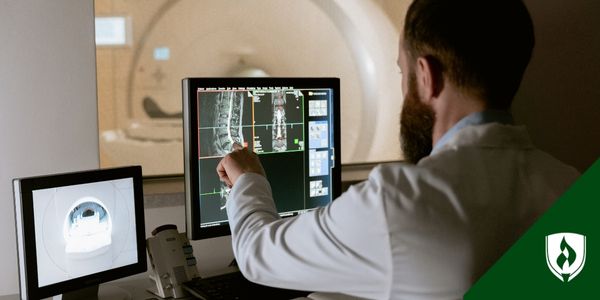What They Don't Tell You in the Radiologic Technologist Job Description
By Callie Malvik on 10/07/2019

Have you ever looked back at the original job posting of a position you ended up landing? Chances are good there were a lot of details missing about what the role actually entailed. Job descriptions are designed to give a taste of the technical aspects of the job, but they just can’t capture it all.
So as you’ve started browsing the job descriptions of radiologic technologist jobs, you can’t help but wonder what they’re missing. There are certain aspects of the job that you can just never know until you’re doing it—or can you?
We connected with Crystal Bromeling, veteran radiologic technologist and Program Coordinator at Rasmussen University, to dig into the details you might not find in a typical radiologic technologist job description. Her firsthand knowledge can help you get a behind-the-scenes look at this fascinating field.
5 Important insights you won’t find in the radiologic technologist job description
It turns out that radiologic technologist jobs entail more than just taking x-rays. Join us as we take a closer look at this rewarding role.
1. Interpersonal skills are incredibly important
Sure, a large part of your training and job revolves around operating and maintaining cutting-edge radiography equipment. But good people-skills are just as vital. Bromeling says that during her schooling she didn’t expect to interact with patients nearly as much as she has as a radiologic technologist. She adds that there are times when patients are going to share deeply personal information, and you need to be ready to offer support regardless of how your day is going.
“I never knew I would need to be a counselor, but it happens a lot when patients are fearful of the outcome of their exam or when explaining how they received an injury,” Bromeling explains. She emphasizes the importance of being compassionate as a rad tech. “You will need to listen to patient stories when they feel you’re a safe person to tell them to.”
2. Quality beats quickness
The images captured by a radiologic technologist play an important role in the diagnosis and overall care of a patient. It can be tempting to move quickly in the face of a growing patient load, especially when first starting out. But you’re much better off being methodical and getting it right on the first attempt.
“Remember, you will be slow at first and that’s okay,” Bromeling assures. “Stay calm, take good images and speed will come with time.” She stresses that you should never rush through an exam for any reason.
3. The work isn’t boring
You might assume the day-to-day life of a radiologic technologist involves a stream of uneventful examinations for relatively routine injuries like broken arms and legs. But don’t fool yourself into thinking it’s dull.
“As a radiologic technologist, you will never have the same work day,” Bromeling explains.
She says one of the biggest surprises for her as she entered the field was that rad techs go into surgery and are present operating radiographic equipment during invasive procedures. Surgery—no matter how you slice it—is a pretty intense experience, so don’t expect monotony.
4. Not every procedure will be ‘by the book’
Fresh out of a radiologic technologist program, it’s only natural to rely on your previous experience and what you’ve learned in class. However, the ‘real world’ doesn’t always fit nicely into those classroom scenarios.
“There are very few patients who are like the book,” Bromeling acknowledges. “Critical thinking is a must for this profession.” This ability to think on your feet is something that isn’t always clear in a dry radiologic technologist job description.
It’s just a hard truth. There are far too many human variables for your schooling to cover every possible situation with a step-by-step guide. Because of this, your ability to adapt to different patients and environments is vital. By having a strong understanding of the fundamental, technical factors that go into producing an image, you should be well-prepared to handle these unanticipated variables.
5. There’s room for growth
You might think that a radiologic technologist position is one in which you land the job and continue working on generally the same stuff until you retire. But that doesn’t have to be the case. The variety and growth opportunities in the field are one of the most enticing benefits radiologic technologist jobs have to offer.
For example, Bromeling’s personal experience includes time working in surgical radiography, mammography, computed tomography and sonography. This is only a portion of the possibilities. Radiologic technologists are needed in nearly every healthcare setting and there’s a wide variety of specializations to explore and advance into.
Examine radiologic technologist jobs
Now that you have a clearer picture of the radiologic technologist job description, can you picture yourself operating diagnostic imaging equipment? The good news is you could make that a reality sooner than you might think.
Most radiologic technologist jobs require an associate’s degree, according to the U.S. Bureau of Labor Statistics.1 That means you could take on this rewarding role in as few as 24 months.2 Check out our Radiologic Technology program page to learn more about the training.
Related Articles:
- Radiologist vs. Radiologic Technologist: Illuminating the Differences
- What Healthcare Workers Need to Know About Radiation Effects
- Examining 5 Commonly Confused Radiology Careers
1Bureau of Labor Statistics, U.S. Department of Labor, Occupational Outlook Handbook, [accessed September 2019]. Information represents national, averaged data for the occupations listed and includes workers at all levels of education and experience. Employment conditions in your area may vary.
2Completion time is dependent on the number of courses completed each term.




